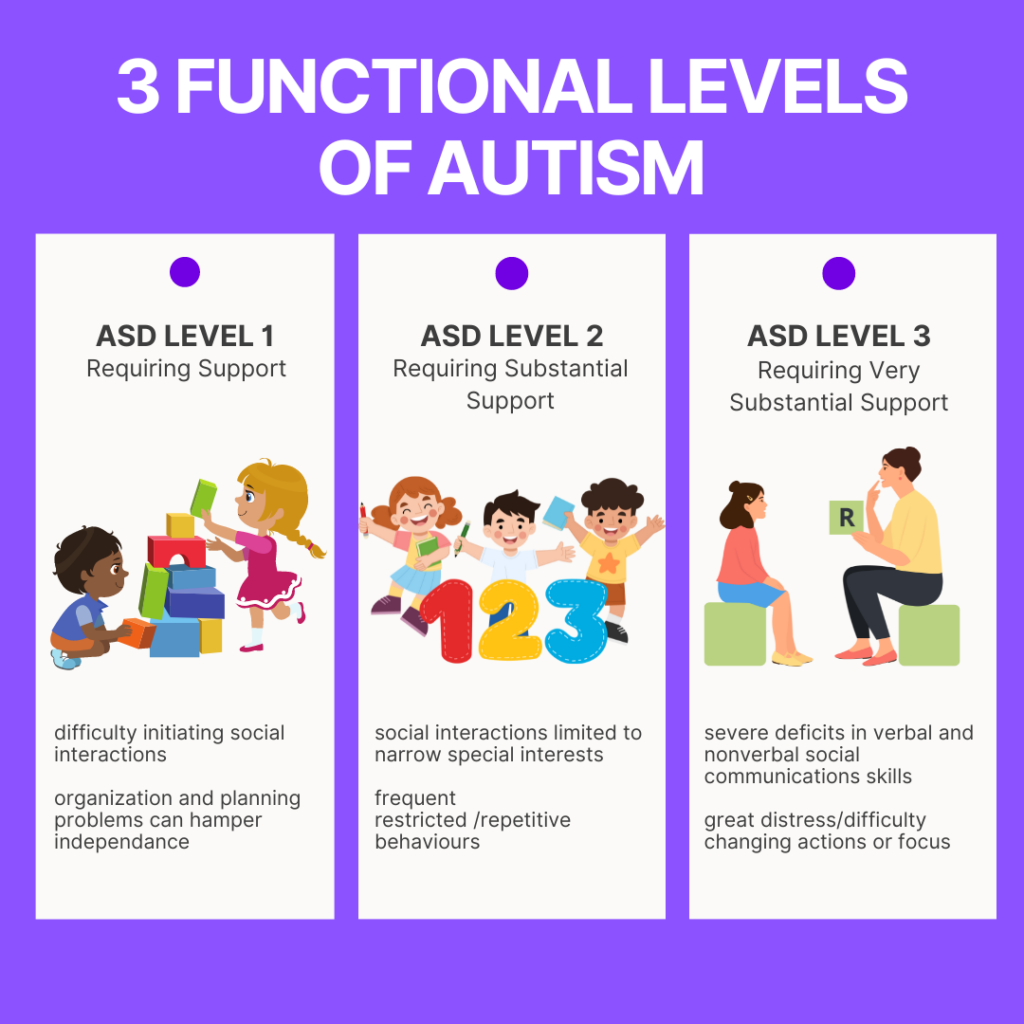Clinically, the American Psychiatric Association states that “Autism Spectrum Disorder (ASD) is a complex developmental condition that involves persistent challenges in social interaction, speech and nonverbal communication, and restricted/repetitive behaviors. The Diagnostic and Statistical Manual of Mental Disorders (DSM-5) includes a wide range of symptoms of varying severity that a person may experience. The term suggests that Autism encompasses a diverse array (a spectrum) of symptoms with varying degrees of impact on individuals’ lives. The consensus within the medical community is that Autism manifests in a broad spectrum of expressions and varying levels of severity.
Kicking around now there is much discussion about the differing levels of autism. The questions being asked;
What do the levels mean they mean?
What is high functioning?
What does non-verbal mean?
There are 3 levels of autism as defined by the Diagnostic and Statistical Manual of Mental Disorders. This is the standard by which everyone is assessed if they are receiving a diagnosis.

Level 1 & 2 is where it gets very fuzzy for people. As a mother I have had other mother’s turn around to me and say well she does not look autistic! My response was “can you explain to me what an autistic child should look like”? Then they start to stutter and fall over themselves.
A level 3 person can, in some cases, talk and perform complex tasks but they have no filter that enables them to interact with a neurotypical society. For this person there is a constant 5 sensory overload within the neurotypical society. They cannot function on what is considered to be a normal platform. There is an understanding from society too so support and allowances are provided, admittedly not in all circumstances but that’s a whole other blog.
An autistic person can have a mix of traits that do not fit neatly into the DSM diagnosis levels (boxes). Generally a person can and will exhibit some traits, sit very clearly in the lower level but other traits will sit very clearly in the higher levels.
What is important to keep in mind is that actual autistic people’s traits and experiences are not as clear-cut as these levels present. Many autistic people have a wide mix of traits associated with multiple levels, so these classifications are not helpful outside of medical contexts.
In reality the levels serve as a means to identify if a person is on the autistic spectrum and to what level of severity. Beyond the medical diagnosis, each person can be clearly defined within the different levels. No, so in a person’s every day world, the levels do not apply and provide no meaning to their lives. Each person has to be taken at face value and treated as an indivdual.
A high-functioning Autisic Person
The term “high-functioning” is controversial within the autism community because of its lack of accuracy and is misinterpreted by society. Additionally, this term is not a medically recognised term.
If you ask a person on the street “what does a high functoning autistic person look like to you?” The answer will be something along the lines of: “A person who has a high levels of intelligence and can also function in society without needing much support.”
Research studies revealed that there’s a weak link between IQ and adaptive behaviors like eating, getting dressed or tying shoelaces and more.
What is considered ”high-functioning”, therefore, is more complicated than just an intelligence level.
There are too many categories for functioning in daily life to label an autistic person as either high- or low-functioning, some of the categories are:
- communication abilities
- social awareness
- information processing
- sensory processing
- motor skills
These categories affect all autistic people differently. An autistic person with a high IQ, would generally be categorized as ”high-functioning” yet could still score low in all social and communication categories and therefore be perceived as a low functioning autistic person.
Being Nonverbal
Nonverbal autism isn’t an actual diagnosis. It’s a term used for a subgroup of people with Autisum who never learn to speak more than a few words.
The term “nonverbal autism” has no official status as a diagnosis, because there is no clear line between verbal and nonverbal autistic people.
Many people who are autistic will say they have periods op being nonverbal. At that point they do not feel the need or cannot verbalise their communication.
But what about the people who are autistic and have never spoken a word? Can some understand the world around them and communicate via other means that is not a verbal communication?
Will others who can verbalise their communication be put in the minimal verbal communication?
Is there a clear answer to the questions above?

Therein lies the problem. We try so hard as a society to understand people’s action by putting them in a specific box that we forget what the basic fundamental element of a human being is. Indivduallity! Levels/Labels/terms have their uses to understand what kind of support a person may require, but that is about as far as it goes.
To answer the question “what do the levels of autism mean” beyond the need for a medical definition; not a lot. Each person has a perspective of what the levels of autisum should look like. In all likelihood, those perspectives are probably all different because they are each an individual with an individual perspective.
Rather than “pop” an autistic person into that or this box; treat them as an individual and respond to them at an individual level. Break those walls down, expand the world; give everyone a chance to feel included.
